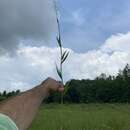Comprehensive Description
(
Anglèis
)
fornì da North American Flora
Panicum scoparium L,am. Encyc. 4: 744. 1797
Panicum pubescens Lam. Hncyc. 4: 748. 1797.
Panicum viscidum Ell. Bot. S. C. & Ga. 1: 123. 1816.
Panicum pauciflorum Bosc; Spreng. Syst. 1: 313, as synonym. 1825.
Vernal plants grayish -olive, velvety-pubescent throughout except as noted; culms 80-130 cm. high, stout, erect or ascending, usually geniculate at base, the nodes villous with reflexed hairs, a glabrous, viscid ring below; leaf -sheaths about half as long as the long internodes, the velvety pubescence wanting on the back toward the summit, the surface here viscid when fresh ; ligule 1 mm. long; blades rather thick, ascending or spreading, often reflexed late in the season, 12-20 cm. long, 10-18 mm. wide, long-acuminate, slightly narrowed to the rounded base, the uppermost leaf often much reduced; panicles finally long-exserted, 8-15 cm. long, nearly as wide, many-flowered, the axis, branches, and pedicels with viscid blotches, the branches ascending or spreading, spikelet-bearing to the base; spikelets 2.4—2.6 mm. long, 1.4-1.5 mm. wide, obovate, turgid at maturity, abruptly pointed, papillose-pubescent with spreading hairs; first glume one fifth to one fourth the length of the spikelet, acute to truncate; second glume and sterile lemma strongly nerved, the glume obtuse, shorter than the fruit at maturity, the lemma abruptly pointed and equaling it; fruit 2 mm. long, 1.4 mm. wide, obovate-elliptic, apiculate.
Autumnal phase leaning or spreading, branching from the middle nodes after the maturity of the primary panicle, the branches usually longer than the primary internodes, repeatedly branching, often more or less scorpioid, the ultimate branchlets in flabellate fascicles, the sheaths often swollen toward the summit, contracted at the throat, the blades much reduced, overtopping the small, partially included panicles.
Type locality : Carolina.
Distribution: Massachusetts to Florida, and west to Oklahoma and Texas.
- sitassion bibliogràfica
- George Valentine Nash. 1915. (POALES); POACEAE (pars). North American flora. vol 17(3). New York Botanical Garden, New York, NY
Physical Description
(
Anglèis
)
fornì da USDA PLANTS text
Perennials, Terrestrial, not aquatic, Rhizomes present, Stems nodes swollen or brittle, Stems erect or ascending, Stems caespitose, tufted, or clustered, Stems terete, round in cross section, or polygonal, Plants conspicuously hairy, grayish, or wooly, Stem internodes hollow, Stems with inflorescence less than 1 m tall, Stems, culms, or scapes exceeding basal leaves, Leaves mostly basal, below middle of stem, Leaves conspicuously 2-ranked, distichous, Leaves sheathing at base, Leaf sheath mostly open, or loose, Leaf sheath hairy, hispid or prickly, Leaf sheath hairy at summit, throat, or c ollar, Leaf sheath and blade differentiated, Leaf blades lanceolate, Leaf blades 2-10 mm wide, Leaf blades 1-2 cm wide, Leaf blades mostly flat, Leaf blades more or less hairy, Inflorescence terminal, Inflorescence an open panicle, openly paniculate, branches spreading, Inflorescence a contracted panicle, narrowly paniculate, branches appressed or ascending, Inflorescence solitary, with 1 spike, fascicle, glomerule, head, or cluster per stem or culm, Inflorescence branches more than 10 to numerous, Flowers bisexual, Spikelets pedicellate, Spikelets dorsally compressed or terete, Inflorescence or spikelets partially hidden in leaf sheaths, subtended by spatheole, Spikelet less than 3 mm wide, Spikelets with 1 fertile floret, Spikelets with 2 florets, Spikelets solitary at rachis nodes, Spikelets all alike and fertille, Spikelets bisexual, Spikelets disarticulating below the glumes, Rachilla or pedicel glabrous, Glumes present, empty bracts, Glumes 2 clearly present, Glumes d istinctly unequal, Glumes equal to or longer than adjacent lemma, Glume equal to or longer than spikelet, Glumes 3 nerved, Glumes 4-7 nerved, Lemma similar in texture to glumes, Lemma coriaceous, firmer or thicker in texture than the glumes, Lemma becoming indurate, enclosing palea and caryopsis, Lemma 3 nerved, Lemma 5-7 nerved, Lemma 8-15 nerved, Lemma glabrous, Lemma apex truncate, rounded, or obtuse, Lemma awnless, Lemma margins inrolled, tightly covering palea and caryopsis, Lemma straight, Palea present, well developed, Palea about equal to lemma, Stamens 3, Styles 2-fid, deeply 2-branched, Stigmas 2, Fruit - caryopsis.
Dichanthelium scoparium: Brief Summary
(
Anglèis
)
fornì da wikipedia EN
Dichanthelium scoparium is a species of grass known by the common names velvet panicum, velvety panicgrass, and broom panicgrass. It is native to North America, where it occurs in the southeastern United States. It also occurs in the West Indies.
This rhizomatous perennial grass produces a basal rosette of leaves in the fall and winter and then erect stems the following spring. There are clumps of stems up to 1.5 meters tall. There are 7 to 11 hairy leaves up to 20 centimeters long by 2 wide on the stem. There are two types of inflorescence. The main panicle has flowers that open and are pollinated. There are also cleistogamous flowers that do not open and fertilize themselves. These develop later in the season. There are about 380,000 seeds per pound.
This grass grows in woodlands and savannas. It may inhabit disturbed habitat.
- licensa
- cc-by-sa-3.0
- drit d'autor
- Wikipedia authors and editors
Panicum scoparium: Brief Summary
(
Indonesian
)
fornì da wikipedia ID
Panicum scoparium adalah spesies tumbuhan yang tergolong ke dalam famili Poaceae. Spesies ini juga merupakan bagian dari ordo Poales. Spesies Panicum scoparium sendiri merupakan bagian dari genus Panicum. Nama ilmiah dari spesies ini pertama kali diterbitkan oleh Lam..
- licensa
- cc-by-sa-3.0
- drit d'autor
- Penulis dan editor Wikipedia

